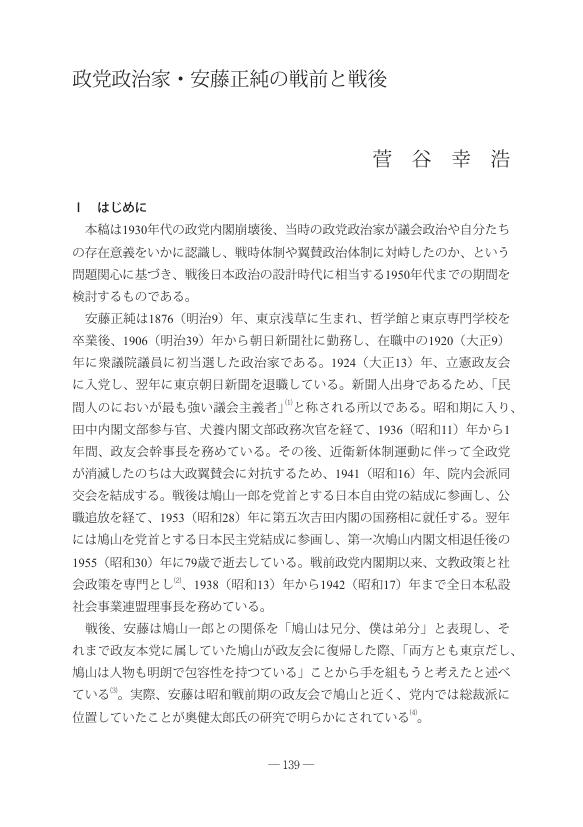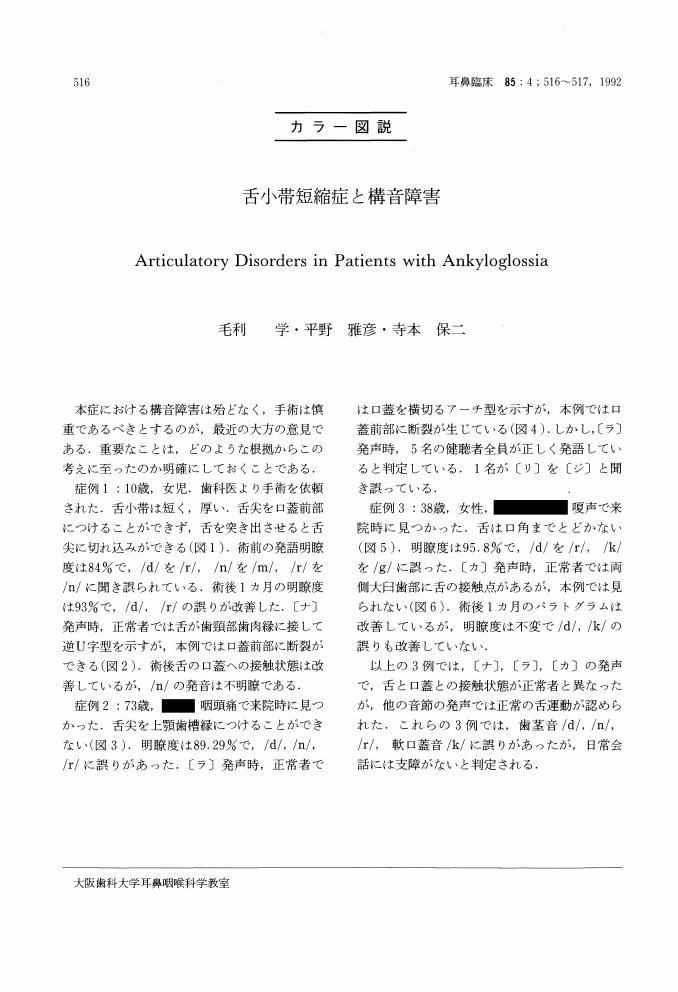- 著者
- 辻元 健士 村上 征勝
- 出版者
- 一般社団法人 映像情報メディア学会
- 雑誌
- 映像情報メディア学会技術報告 (ISSN:13426893)
- 巻号頁・発行日
- vol.34, pp.35-38, 2010
- 参考文献数
- 3
本研究では,葛飾北斎作『富嶽三十六景』を対象とし,原型の絵画と構図的変化を加えた絵画の二種類を用いて,構図変化の影響を印象評価と視線移動の観点から数量的な比較分析を試みた.印象評価では,構図型,変化の方法,順序効果の3つの観点から比較分析を行った.視線移動では,絵画を観る時の視線移動総面積を分析し,構図を変化させることで印象評価に差が生まれること.また,印象評価の基準の一つとして視線移動総面積が有意な要因であるという結果を得た.
3 0 0 0 OA 政党政治家・安藤正純の戦前と戦後
- 著者
- 菅谷 幸浩
- 出版者
- 日本法政学会
- 雑誌
- 法政論叢 (ISSN:03865266)
- 巻号頁・発行日
- vol.54, no.2, pp.139, 2018 (Released:2018-09-27)
3 0 0 0 OA 古英雄之俤
- 著者
- 町田源太郎 (柳塘・楓村) 編
- 出版者
- 晴光館[ほか]
- 巻号頁・発行日
- 1910
- 著者
- 戸田 善治 竹内 裕一 姜 雪婷 三浦 輔 宮田 知佳 山本 晴久 和田 敦実
- 出版者
- 千葉大学教育学部
- 雑誌
- 千葉大学教育学部研究紀要 (ISSN:13482084)
- 巻号頁・発行日
- vol.61, pp.133-143, 2013-03
本稿は,2011年度に社会科教育教室が開講した大学院授業「授業研究(社会)」における大学教員と大学院生の共同研究の報告である。日本政府は1990年に「入管法」を改正,すべての外国人を就労可・不可にはっきりと区別し,不法就労外国人に対する取り締まりを開始した。一方で,「定住者」資格を認めたブラジル・ペルー出身の日系人に就労を許可し,さらに「研修・実習」制度を中小企業にも活用しやすいように規制緩和し,事実上の就労を認め,この制度の目的が「途上国への技術移転,人材育成」であると一貫して主張してきた。これに対して,受け入れ企業は「単純労働力確保」,中国人実習生は「カネ稼ぎ」を目的とし,この両者間ではWIN-WINの関係にあり,日本政府のいう制度の目的とその運用実態には大きな乖離がある。そこで,この乖離状態に着目し,「外国人技能実習制度」の是非及びその改革案について考える授業を開発した。
3 0 0 0 風景バーテンダー:カクテルのアナロジを用いた風景生成
本論文では,カクテルのアナロジを用いることにより風景画像を作成するシステムを提案する.このシステムではカクテルの材料を風景の要素とし,それらをシェーカで混ぜる事で風景を作成する事が出来る.作成される風景画像はシェーカを振ることでリアルタイムに変化し,体験者は風景画像を作成している感覚を持つことが出来る.また,風景の要素の組み合わせで,出来上がる風景画像は異なってくる.これにより,体験者はオリジナルの風景画像を作成する事ができる.
3 0 0 0 OA 東日本大震災前後における生活習慣病の推移:福島県県民健康調査
- 著者
- 大平 哲也 中野 裕紀 岡崎 可奈子 林 史和 弓屋 結 坂井 晃 福島県県民健康調査グループ
- 出版者
- National Institute of Public Health
- 雑誌
- 保健医療科学 (ISSN:13476459)
- 巻号頁・発行日
- vol.67, no.1, pp.34-41, 2018-02-01 (Released:2018-04-14)
- 参考文献数
- 20
2011年 3 月11日,東日本大震災が発生し,それに引き続き福島第一原子力発電所の放射線事故が起こった.原子力発電所周辺の多くの住民が避難を余儀なくされ,生活習慣に変化が起こってきた.そこで,各市町村で実施している健康診査、及び福島県で実施している県民健康調査のデータを用いて、震災後の避難が循環器疾患危険因子及び生活習慣病に影響する可能性を検討した。本稿では,震災前後における健康診査結果の変化及び県民健康調査の生活習慣病に関する縦断的検討の結果を概説する.震災前後において健康診査データを比較した結果,震災後,避難区域住民においては過体重・肥満の人の割合,及び高血圧,糖尿病,脂質異常,肝機能異常,心房細動,多血症有病率の上昇がみられた.さらに,震災後 1 ~ 2 年間と 3 ~ 4 年間の健診データを比較したところ,糖尿病,脂質異常についてはさらなる増加がみられた.したがって,避難区域住民,特に実際に避難した人においては心筋梗塞や脳卒中などの循環器疾患が震災後に起こりやすくなる可能性が考えられた.また、これらの要因としては震災後の仕事状況の変化、避難による住居の変化などによる身体活動量の低下、心理的ストレスの増加などが考えられた.今後,避難者の循環器疾患を予防するために,地域行政と地域住民が協働して肥満,高血圧,糖尿病,脂質異常の予防事業に取り組む必要がある.
3 0 0 0 OA 母乳および産褥期血清中の亜鉛と銅
- 著者
- 前田 隆子 田中 俊行 大城 等 船川 一彦 能勢 隆之 今井 昭二 林 康久
- 出版者
- The Japanese Society for Hygiene
- 雑誌
- 日本衛生学雑誌 (ISSN:00215082)
- 巻号頁・発行日
- vol.45, no.3, pp.781-787, 1990-08-15 (Released:2009-02-17)
- 参考文献数
- 21
- 被引用文献数
- 2 2
This study reports the contents of Zn and Cu in the breast milk and serum of postpartum mothers, 17 primiparas and 20 multiparas, at one week and at one month after delivery.Results were as follows.1. The mean content of Zn in the breast milk was 5.44μg/ml at 1 week after delivery, and it decreased significantly (p<0.01) to 2.73μg/ml at 1 month after delivery.2. The mean content of Zn in serum was 0.66μg/ml at 1 week, and it increased significantly (p<0.01) to 0.84μg/ml, close to the normal level, at 1 month.3. The milk Zn level at 1 week after delivery was about 8 times as high as the Zn in serum. There was a significant (p<0.05) negative correlation in Zn contents between milk and serum at 1 week after delivery, and there was no significant correlation in Zn contents between milk and serum at 1 month after delivery.4. The mean content of Cu in breast milk was 0.55μg/ml at 1 week after delivery, and it decreased to 0.44μg/ml at 1 month after delivery.5. The mean content of Cu in serum was 2.14μg/ml at 1 week after delivery, and it decreased significantly (p<0.01) to 1.35μg/ml, close to the normal level, at 1 month after delivery.6. Concerning the Cu contents of milk and serum, there was not a significant correlation at 1 week after delivery, but a significant (p<0.05) positive correlation was found at 1 month after delivery.
3 0 0 0 OA 官報
- 著者
- 大蔵省印刷局 [編]
- 出版者
- 日本マイクロ写真
- 巻号頁・発行日
- vol.1921年05月18日, 1921-05-18
3 0 0 0 OA 官報
- 著者
- 大蔵省印刷局 [編]
- 出版者
- 日本マイクロ写真
- 巻号頁・発行日
- vol.1927年08月09日, 1927-08-09
3 0 0 0 OA 官報
- 著者
- 大蔵省印刷局 [編]
- 出版者
- 日本マイクロ写真
- 巻号頁・発行日
- vol.1927年09月26日, 1927-09-26
3 0 0 0 OA ハシブトガラスとハシボソガラスにおける胃および十二指腸の形態学的研究
- 著者
- 三瓶 明希夫 本田 翼 毛利 明博
- 出版者
- 一般社団法人日本物理学会
- 雑誌
- 日本物理学会講演概要集 (ISSN:2189079X)
- 巻号頁・発行日
- vol.71, no.1, 2016-03-19
- 著者
- TOMO TAKANO MASATO NAKATSUKASA YUTAKA KUNIMATSU YOSHIHIKO NAKANO NAOMICHI OGIHARA HIDEMI ISHIDA
- 出版者
- The Anthropological Society of Nippon
- 雑誌
- Anthropological Science (ISSN:09187960)
- 巻号頁・発行日
- vol.126, no.3, pp.135-149, 2018 (Released:2018-12-21)
- 参考文献数
- 59
- 被引用文献数
- 10
This paper provides a thorough description of humeral, ulnar, and radial specimens of the Nacholapithecus holotype (KNM-BG 35250). A spool-shaped humeral trochlea (and keeled sigmoid notch of the ulna) is a hallmark of elbow joint evolution in hominoids. In lacking this feature, the elbow of Nacholapithecus is comparatively primitive, resembling that of proconsulids. However, the humeroulnar joint in Nacholapithecus is specialized for higher stability than that in proconsulids. The humeroradial joint (humeral capitulum) resembles that of extant apes and Sivapithecus. This condition may represent an intermediate stage leading to the fully modern elbow in extant apes. If this is the case, specialization of the humeroradial joint preceded that of the humeroulnar joint. Nacholapithecus elbow joint morphology suggests more enhanced forearm rotation compared to proconsulids. This observation accords with the forelimb-dominated positional behavior of Nacholapithecus relative to proconsulids, which has been proposed on the grounds of limb proportions and the morphology of the phalanges, shoulder girdle, and vertebrae.
- 著者
- 品田 悦一
- 出版者
- 日本文学協会
- 雑誌
- 日本文学 (ISSN:03869903)
- 巻号頁・発行日
- vol.51, no.4, pp.1-13, 2002-04-10 (Released:2017-08-01)
『万葉集』のことばは、それを使用した古代人にとっては決して国語ではなかった。それは畿内の貴族たちのことばであり、また倭歌という特殊な文化を背負う言語であって、古代国家の版図の津々浦々に通用するような性格は持ち合わせてはいなかった。明治中期に過去の諸テキストから国民の古典が選出されたとき、それら諸テキストの使用言語は過去の国語として追認された。とりわけ『万葉集』のことばは、国語の「伝統」の栄えある源泉として仰がれ、この観念のもと、万葉調の短歌がさかんに創作される。興味深いのは、近代短歌の使用言語が、古代語そのものでも、それと現代語との混融物でもなかったという点だろう。伝統の復興であるべきものが、その実、いまだかつて存在しなかった言語を新たに作り出してしまったのだ。その言語は、しかも、歌壇の外側にはほとんど通用しないという点で、事態を導いた「国語」の理念を裏切ってもいた。素朴で自然で、原始的生命力に満ちていて、そのうえ意味不明な言語。こいつはいったい、なんという鵞鳥だい。
3 0 0 0 IR 国政選挙における投票率と投票所数との関係
- 著者
- 光延 忠彦
- 出版者
- 千葉大学大学院人文公共学府
- 雑誌
- 千葉大学人文公共学研究論集 = Journal of Studies on Humanities and Public Affairs of Chiba University (ISSN:24332291)
- 巻号頁・発行日
- vol.36, pp.237-246, 2018-03-29
[要旨] 2000年代初頭から行われた「平成の市町村合併」と、2009年の政権交代後に新政権によって行われた「事業仕分け」とによって、国政選挙における投票所数は、島根県や県内自治体はもとより他の都道府県でも削減された。このような制度改正と並行して、2000年代中葉期を分岐に島根県はもとより県内自治体の投票率は、従来の横ばいから逓減傾向へと移行した。果たして投票所数の削減は投票率に何らかの影響を及ぼしたのであろうか。従来の研究では、投票所数と投票率の関係はあまり議論されて来なかったが、本稿は、こうした疑義を検討するための準備として、いくつかの論点を考察してみたい。
3 0 0 0 OA 古代メソポタミアにおける神名の解釈学
- 著者
- 柴田 大輔
- 出版者
- 一般社団法人 日本オリエント学会
- 雑誌
- オリエント (ISSN:00305219)
- 巻号頁・発行日
- vol.49, no.2, pp.22-39, 2006 (Released:2010-03-12)
The explanation of names of deities played a significant role in the theology of ancient Mesopotamia. The most important example of such an explanation is Enuma eliš VI 121-VII 144, where Marduk is invested with his fifty different names, alongside “explanatory epithets” which interpret each of the names. The significance given to the names and explanatory epithets in the ancient theology can be seen, above all, in commentaries to Enuma eliš.The present article deals with a hitherto overlooked example of such explanatory epithets of Marduk, mentioned in the Sumerian Šuilla-prayer ur-sag úru ur4-ur4, “Hero, Devastating Flood”. In the litany of this prayer Marduk is addressed with names which belong to the fifty names in Enuma eliš. Each name is followed by an explanatory epithet. Based on comparable evidence from explanatory epithets in other texts, the way in which these epithets stem from the names of Marduk will be analyzed. In light of the editorial history of the prayer and the purpose of its recitation in cult, the reason for the mention of the names and epithets of Marduk in the prayer will be further investigated.
3 0 0 0 OA マルドゥクの「50の名前」の意味について
- 著者
- 松島 英子
- 出版者
- 一般社団法人 日本オリエント学会
- 雑誌
- オリエント (ISSN:00305219)
- 巻号頁・発行日
- vol.51, no.1, pp.165-180, 2008-09-30 (Released:2014-03-30)
Though the “Fifty Names” of Marduk in Enūma eliš (below called Ee) is famous in Babylonian literature, we have not intensively discussed the significance of “fifty” names. VI 123 to VII 136 of Ee contain in fact fifty-one names. However, the epic insists on “fifty”, the number generally attributed to Enlil, the head of the pantheon before Marduk. Ee mentions the number “fifty” for the first time at the birth of Marduk and uses it repeatedly whenever the story takes a new turn. Analyzing the epic, We suspect that the author(s) made use of this number, in order to emphasize that the kingship of the Babylonian pantheon was transfered from Enlil to Marduk. We have two related texts with Neo-Assyrian manuscrips. One, CT 25, 50+ Rm 52 contains the mystical numbers of the gods. Here, the fifty is attributed to Enlil and Ninurta, and ten to Marduk. The tablet was copied by the scribe at the reigns of Sargon and Sennacherib. Another text, CT 13, 32, a commentary on Ee, says on rev.12’ the following “fifty = hansā, fifty is dBE”. dBE generally indicates Enlil, but the texts giving the reading have recently been found. It is thus possible to interprete the rev.12’ as “fifty hansā, fifty is dBE(=Marduk)". This reading seems most probable since the first half of rev.12’ is the same as Ee VII 144. The use as dBE= dBēl dates the copy to the same period as CT 25, 50+ Rm 52. But at that time dBE may still have indicated Enlil as well. Perhaps, the author of CT 13, 32 made use of this double understanding to emphasize that the kingship of the gods had been transtered from Enlil to Marduk.

